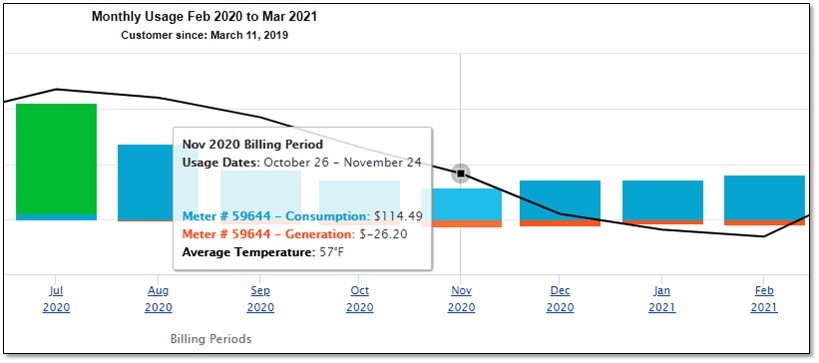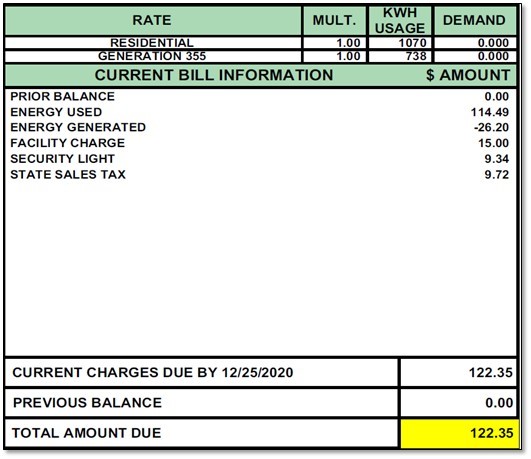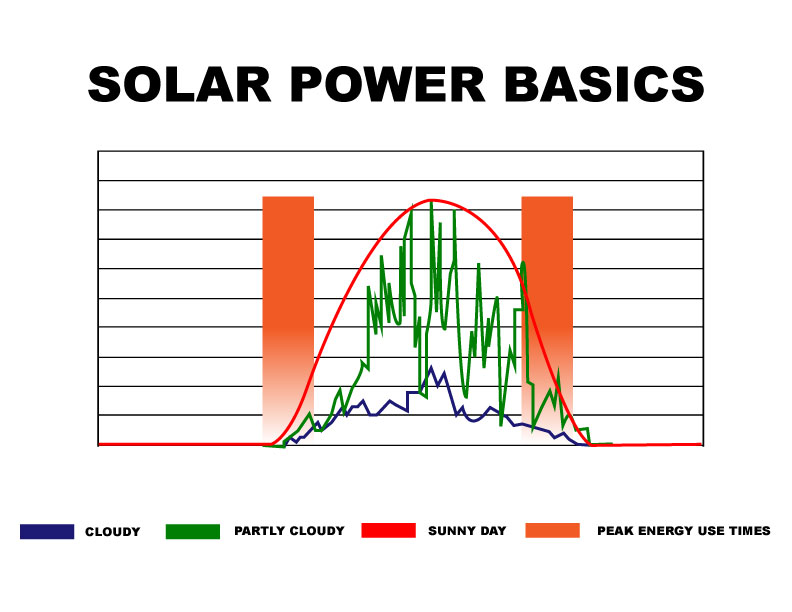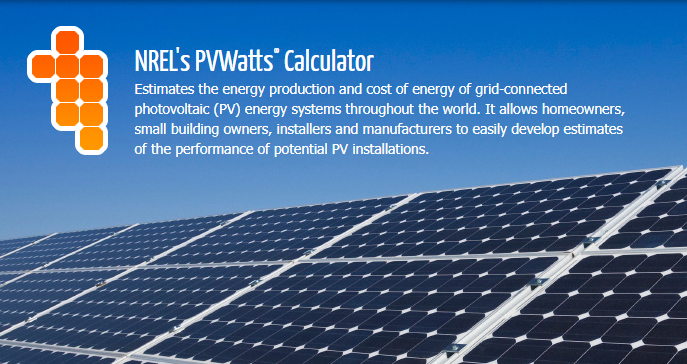Are you thinking about solar? Wake Electric supports renewable energy efforts and has developed a program for members who wish to generate their own electricity. If you are considering installing solar, we recommend that you read the information below. If you still have any questions, please feel free to contact us.
Solar Power Information
Solar energy systems work when sunlight hits a solar photovoltaic module (solar panel or PV panel) and causes electric current to flow. The current produced from the PV panels is controlled and regulated by an inverter, which converts direct current (DC) to alternating current (AC), needed for use by household appliances. The electrical panel is where the power gets distributed throughout your house; any excess electricity may be sent from the panel back to Wake Electric’s power grid.
Note that you can start out small and add on. A system that will generate 100 percent of your energy needs is expensive, so most systems are sized to generate only a portion of your home’s needs. You can find online calculators to help answer this question in more detail, and installers can provide details about your situation too.
The actual amount of energy produced by a system depends on the location. Typical home rooftop systems are sized to produce between 2 and 10kilowatts (kW). On average, 75 square feet of solar panels are needed to produce each kilowatt of direct current (DC) power during peak solar periods.
- This is a personal decision based on your financial goals which could change significantly if you are installing batteries.
- We would recommend some analysis to maximize the return on investment of a solar system.
- Examine your hourly energy use on our member portal.
- Focus on the energy used between the hours of 10 a.m. and 4 p.m. because those are the hours that the sun is directly over most installations. When the sun is on the horizon, electricity production is greatly diminished.
- Look at months in different seasons, such as January, April, July and November, to see how your energy use changes throughout the year.
- For the most payback, build a system that covers your usage only during those time periods.
- Build a system that sells back as little electricity as possible as the additional cost of installing more panels than you need to power your home is offset by a lower rate.
- At this time, residential batteries are fairly expensive.
- Batteries can provide the homeowner a backup source of power during an outage. It is a common misconception that a solar array can power a home during an outage. Many outages occur as a result of storms which would decrease the sunlight available for your system. Even on a sunny day the solar panel produces direct current (DC) which cannot be used by your home. The direct current produced by your solar array is converted to alternating current (AC) using an inverter which requires power from Wake Electric’s grid. A battery can be used as a direct source of power for your home or it can power your inverter to convert direct current to alternating current and provide power during an outage..
- Batteries also allow a homeowner to store excess power instead of putting back onto the electric grid at our avoided cost rate.
- Once the electricity is stored, the homeowner can use that power at a later time, offsetting our normal rate which is higher than our avoided cost rate.
- You may want to consider our time-of-use (TOU) rate since the stored power could be used during the higher TOU rate periods.
Certified PV products and systems generally are reliable, with a life expectancy of about 30 years. Manufacturers test PV panels for hail impact, high wind, and freeze-thaw cycles to represent real-life situations. Most manufacturers offer 20- to 25-year warranties for panels; extended warranties may be available at an extra cost.
Little maintenance is required; occasionally it may be necessary to rinse modules off with water to remove dust and grime. Other components like inverters may have a shorter life. PV panels may outlast the roof they are attached to. Make sure your roof is in good shape or budget for replacement during the life of the system.
Most grid-connected PV systems shut down to prevent back feeding electricity into de-energized power lines that may have fallen or that line crew members may be working on. It’s important to have this shut-down feature to prevent injuries, and even death, to those working on the line.
To begin, you can look at factors such as which direction your home faces, the condition of your roof, and obstructions such as trees and other buildings that may block the sun during the peak generation period of 10 a.m. to 4 p.m. Solar contractors can provide a more detailed analysis on what to expect, and your cooperative can offer advice too.
Yes, but they can be complicated and vary by state, city and utility, and may also depend on whether the system is purchased or leased. Find information about the incentives available to you at https://programs.dsireusa.org/system/program/maps. Be sure to consult with your financial and tax advisor.
No, Wake Electric manages the distribution electric system serving its members and does not install residential generation at this time.
Wake Electric’s goal is to provide an easy process for local professional installers to interconnect at our member’s home or business.
The interconnection agreement can be found on our website by clicking here.
- Wake Electric does not endorse any specific installers and cannot guarantee the results of using these organizations.
- Wake Electric will work with any installer and there are several installers that are familiar with our processes and rates.
- We recommend you ask your installer if they have worked with Wake Electric. If they are not familiar with Wake Electric, we are happy to have a conversation about our process and policies with those installers before you make a commitment.
- There are no fees to apply with the Interconnection Agreement.
- For systems less than 25 kW there is no additional monthly fee.
- For systems of 25 kW to 100 kW there is a $7.50 fee added to the monthly facilities charge.
- For systems of 100 kW to 500 kW there is a $75.00 fee added to the monthly facilities charge.
- Charges for systems greater than 500 kW will be treated as a special case and will be negotiated by our power supply association, NCEMC.
- Most meters on the Wake Electric system are capable of measuring electricity in two directions.
- Electricity supplied from the utility to the member’s home or business.
- Electricity generated by the member and delivered back to the utility grid.
- Any electricity generated that is consumed by the member does not get metered because that electricity is being used on the premises and does not pass through the meter.
- Net metering functionality is not standard on non-renewable locations, but the meter can be re-programmed once the renewable generation has been installed and inspected by the appropriate authorities (town, county, etc.).
- Yes, Wake Electric offers a modified net metering rate for all installations since 2016.
- Wake Electric offers our avoided cost rate for all electricity delivered back to the utility grid.
- Members will see two line items on their bill.
- A quantity of electricity delivered from the utility to the member (charge).
- A quantity of electricity generated by the member and delivered back to the utility grid (credit).
- Avoided cost is the rate at which Wake Electric can purchase electricity from alternative sources (nuclear, natural gas, etc.) at various times of the day.
- Wake Electric’s wholesale costs change throughout the day, but our regular retail rate helps us manage the market fluctuations throughout the day.
- Wake Electric’s wholesale costs are higher in the early evenings of the summer and during early morning hours of the winter when solar is not typically available.
- Review Rate and Charges for Net Metering/Renewable Generation Credit Rider (Rider “NM-RGC1”).
- Know that: Renewable generation must be manufactured, installed and operated in accordance with governmental and industry standards. Also, the member is responsible for all environmental and other permits required by governmental agencies prior to construction, installation and interconnection of the renewable generation.
- Complete Wake Electric’s Residential and Small Commercial Standard Interconnection Agreement and send to renewableinstalls@wemc.com.

Energy use on SmartHub

Solar credit on your bill
Yes, the PVWatts® calculator (available through the National Renewable Energy Laboratory) estimates the energy production and cost of energy of grid-connected photovoltaic (PV) energy systems. This is a free application that allows consumers to easily develop estimates of the performance of potential PV installations. NREL is a third-party research laboratory of the U.S. Department of Energy and the Office of Energy Efficiency and Renewable Energy and is not associated with Wake Electric.

Remember, you can examine your hourly energy use on our member portal. Focus on the energy used between the hours of 10 a.m. and 4 p.m. because those are the hours that the sun is directly over most installations. When the sun is on the horizon, electricity production is greatly diminished.
Look at months in different seasons, such as January, April, July and November, to see how your energy use changes throughout the year. For the most payback, build a system that covers your usage only during those time periods. Build a system that sells back as little electricity as possible as the additional cost of installing more panels than you need to power your home is offset by a lower rate.
If you have questions, call Wake Electric at 1.800.474.6300 or 919.863.6300 or email at renewableinstalls@wemc.com.

